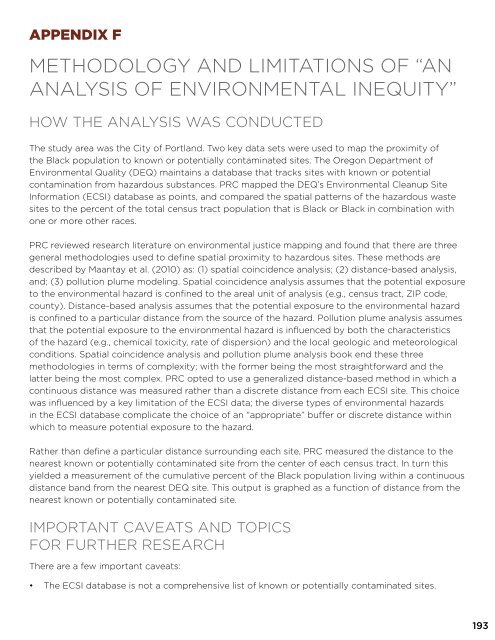State-Of-Black-Oregon-2015
State-Of-Black-Oregon-2015
State-Of-Black-Oregon-2015
You also want an ePaper? Increase the reach of your titles
YUMPU automatically turns print PDFs into web optimized ePapers that Google loves.
APPENDIX FMETHODOLOGY AND LIMITATIONS OF “ANANALYSIS OF ENVIRONMENTAL INEQUITY”HOW THE ANALYSIS WAS CONDUCTEDThe study area was the City of Portland. Two key data sets were used to map the proximity ofthe <strong>Black</strong> population to known or potentially contaminated sites. The <strong>Oregon</strong> Department ofEnvironmental Quality (DEQ) maintains a database that tracks sites with known or potentialcontamination from hazardous substances. PRC mapped the DEQ’s Environmental Cleanup SiteInformation (ECSI) database as points, and compared the spatial patterns of the hazardous wastesites to the percent of the total census tract population that is <strong>Black</strong> or <strong>Black</strong> in combination withone or more other races.PRC reviewed research literature on environmental justice mapping and found that there are threegeneral methodologies used to define spatial proximity to hazardous sites. These methods aredescribed by Maantay et al. (2010) as: (1) spatial coincidence analysis; (2) distance-based analysis,and; (3) pollution plume modeling. Spatial coincidence analysis assumes that the potential exposureto the environmental hazard is confined to the areal unit of analysis (e.g., census tract, ZIP code,county). Distance-based analysis assumes that the potential exposure to the environmental hazardis confined to a particular distance from the source of the hazard. Pollution plume analysis assumesthat the potential exposure to the environmental hazard is influenced by both the characteristicsof the hazard (e.g., chemical toxicity, rate of dispersion) and the local geologic and meteorologicalconditions. Spatial coincidence analysis and pollution plume analysis book end these threemethodologies in terms of complexity; with the former being the most straightforward and thelatter being the most complex. PRC opted to use a generalized distance-based method in which acontinuous distance was measured rather than a discrete distance from each ECSI site. This choicewas influenced by a key limitation of the ECSI data; the diverse types of environmental hazardsin the ECSI database complicate the choice of an “appropriate” buffer or discrete distance withinwhich to measure potential exposure to the hazard.Rather than define a particular distance surrounding each site, PRC measured the distance to thenearest known or potentially contaminated site from the center of each census tract. In turn thisyielded a measurement of the cumulative percent of the <strong>Black</strong> population living within a continuousdistance band from the nearest DEQ site. This output is graphed as a function of distance from thenearest known or potentially contaminated site.IMPORTANT CAVEATS AND TOPICSFOR FURTHER RESEARCHThere are a few important caveats:• The ECSI database is not a comprehensive list of known or potentially contaminated sites.193


